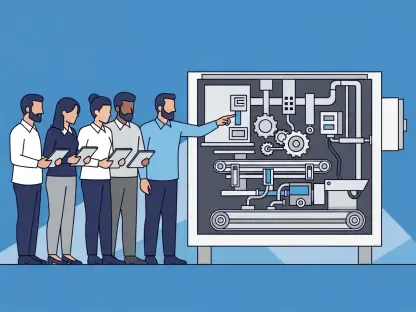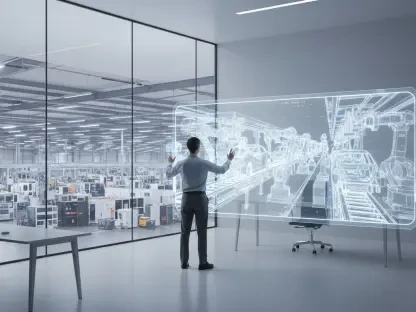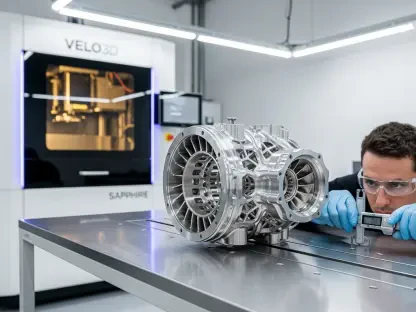The global manufacturing sector finds itself at a critical juncture in the second quarter of 2025, wrestling with persistent stagnation that shows no significant improvement from the initial months of the year, as highlighted by a recent report from Interact Analysis. This sobering picture reveals an industry hampered by economic and geopolitical uncertainties, with US trade policies emerging as a central obstacle. These policies, particularly tariffs introduced by the Trump administration, have instilled a pervasive sense of caution among businesses worldwide, leading to delayed investments and a broader slowdown. Despite this challenging landscape, there are faint signs of optimism, as the Manufacturing Industry Output Tracker (MIO Tracker) projects a modest global output growth of 2.1% for the current year, driven largely by contributions from economic giants like China and the United States. This complex scenario underscores a narrative of struggle intertwined with resilience, where adaptation to emerging trends and regional dynamics will be key to navigating the uncertain path ahead.
Economic and Policy Challenges
Trade Uncertainties Dampen Growth
The dominant force behind the manufacturing sector’s lack of progress in Q2 2025 lies in the uncertainty surrounding US trade policies, which have cast a long shadow over global industry confidence. Tariffs imposed by the Trump administration have not only disrupted established supply chains but also created an environment where businesses are hesitant to make bold moves. This pervasive doubt has led to a significant slowdown in decision-making processes, with many companies adopting a cautious stance until more clarity emerges on the policy front. The ripple effects are felt across borders, as international partners reevaluate their strategies in response to potential cost increases and market access barriers. While some sectors anticipated a stabilization of trade relations, the ongoing ambiguity continues to stifle momentum, leaving manufacturers in a state of limbo as they grapple with unpredictable economic conditions.
Beyond the immediate impact of tariffs, the broader geopolitical climate adds another layer of complexity to the manufacturing landscape. Tensions between major economies have intensified concerns over long-term trade agreements, further eroding trust in global markets. Smaller nations, often reliant on export-driven growth, find themselves particularly vulnerable to these shifts, as they lack the economic clout to influence policy outcomes. The report highlights that until a resolution or at least a predictable framework for trade policies is established, the sector’s ability to plan for growth remains severely constrained. This uncertainty not only hampers current operations but also casts doubt on future expansions, as companies weigh the risks of investing in an unstable environment against the need to remain competitive in a rapidly evolving global economy.
Impact on Investment and Capital Expenditure
The direct fallout from trade uncertainties manifests starkly in the realm of investment and capital expenditure within the manufacturing sector. Companies, wary of unpredictable costs tied to tariffs and shifting policies, have scaled back on plans for expansion and modernization of facilities. This retreat from capital spending is not merely a short-term reaction but a strategic move to preserve resources amid fears of prolonged economic turbulence. The hesitation to invest in new technologies or infrastructure upgrades means that many manufacturers risk falling behind in efficiency and innovation, potentially widening the gap between industry leaders and laggards. The MIO Tracker data suggests that this conservative approach, while protective in the near term, could have lasting repercussions on the sector’s global competitiveness if sustained over multiple quarters.
Moreover, the timing of other economic factors has compounded the challenges faced by manufacturers in allocating capital effectively. Although recent declines in interest rates might typically encourage investment by reducing borrowing costs, the overlap with trade policy disruptions has muted any potential recovery. Businesses are caught in a bind, unable to capitalize on favorable financial conditions due to overarching uncertainties that overshadow market signals. This delay in capital expenditure not only slows immediate growth but also postpones the adoption of critical advancements that could enhance productivity and sustainability. As a result, the sector finds itself in a precarious position, balancing the need to conserve resources with the imperative to prepare for future demands in an increasingly competitive global marketplace.
Regional Performance Disparities
Europe: A Tale of Two Realities
Across Europe, the manufacturing sector presents a stark contrast between struggling industrial powerhouses and emerging smaller economies that are carving out unexpected gains. Nations like Germany and France, long considered the backbone of European industry, are mired in stagnation, burdened by broader economic challenges and a lack of policy cohesion at the regional level. High operational costs, coupled with exposure to global trade disruptions, have hindered their ability to regain momentum, leaving these giants grappling with declining output and shrinking market confidence. The report indicates that without targeted interventions or a shift in external conditions, these key players risk a prolonged period of underperformance, which could reshape the continent’s industrial hierarchy in the coming years.
In sharp contrast, smaller European economies such as Poland and Spain are demonstrating remarkable resilience, capitalizing on their agility to adapt to changing market dynamics. These nations have attracted investment by offering competitive labor costs and flexible regulatory environments, positioning themselves as viable alternatives to traditional manufacturing hubs. Their ability to gain market share amid widespread uncertainty reflects a broader trend of shifting industrial power within Europe, where adaptability often trumps scale. As these smaller players continue to build on their momentum, they challenge the status quo, prompting larger economies to rethink strategies for maintaining relevance. This divergence underscores the importance of localized strengths in navigating a turbulent global landscape, offering lessons for broader recovery efforts across the region.
Asia-Pacific: Innovation Drives Optimism
The Asia-Pacific (APAC) region stands out as a relative bright spot in the global manufacturing narrative, buoyed by strategic investments in cutting-edge technologies like artificial intelligence (AI). Larger economies and established semiconductor hubs within APAC are leveraging these advancements to drive productivity and innovation, positioning themselves at the forefront of industrial evolution. This focus on technology not only offsets some of the negative impacts of global trade uncertainties but also enhances the region’s appeal as a destination for high-value manufacturing activities. The proactive adoption of AI and automation reflects a forward-thinking approach, ensuring that APAC remains a critical player in shaping the future of the sector amid widespread challenges.
Additionally, geopolitical diversification efforts in APAC have further strengthened the region’s manufacturing outlook by reducing reliance on single markets or trade partners. By fostering a network of economic alliances and investing in domestic capabilities, countries in this region are mitigating risks associated with external policy shifts, such as US tariffs. This strategic positioning allows APAC to maintain a degree of stability even as other regions falter, creating a buffer against global economic headwinds. The report suggests that this combination of technological leadership and geopolitical adaptability could serve as a model for other regions, highlighting how innovation and foresight can transform challenges into opportunities. As APAC continues to build on these strengths, it sets a benchmark for resilience in an otherwise uncertain industrial environment.
Sub-Sector Struggles and Opportunities
Machinery Sector Under Strain
Within the broader manufacturing landscape, the global machinery sector emerges as a critical area of concern, battered by a combination of historical and contemporary economic pressures. Elevated interest rates over recent periods have significantly curbed production, leading to an accumulation of excess inventory that triggered a widespread destocking phase. This process, while necessary to correct overstock, has temporarily slowed output across key markets, delaying recovery in a sub-sector that serves as the backbone of industrial operations. Although the destocking phase appears to be nearing its conclusion, the damage to production timelines and market confidence lingers, creating a challenging environment for manufacturers reliant on machinery to drive broader sector growth.
Compounding these issues, the abrupt introduction of US tariffs has delivered a severe blow to the machinery sector’s nascent recovery efforts. The uncertainty surrounding these tariffs has led to a marked pause in anticipated capital expenditure, as businesses adopt a cautious stance in the face of potential cost escalations. While a brief surge in orders occurred ahead of tariff deadlines, the report warns that post-implementation, new orders are likely to decline sharply, further depressing production levels. This dual impact of destocking and trade barriers illustrates the compounded difficulties faced by the machinery sub-sector, highlighting the urgent need for policy clarity to restore momentum. Until such stability is achieved, manufacturers in this space must navigate a precarious balance between maintaining operations and preparing for an uncertain future.
Emerging Trends as Growth Catalysts
Amid the pervasive challenges facing manufacturing, certain emerging trends offer a glimmer of hope for revitalizing the sector over the long term, particularly through nearshoring initiatives in the Americas. By relocating production closer to consumer markets, companies are reducing exposure to global supply chain disruptions and tariff-related costs, enhancing operational efficiency. This shift not only mitigates risks tied to international trade tensions but also fosters stronger regional economic ties, creating a more resilient manufacturing base. The report identifies nearshoring as a strategic pivot that could drive growth in the Americas, provided that economic conditions stabilize and supportive policies encourage sustained investment in local infrastructure and workforce development.
Simultaneously, AI-driven advancements in the Asia-Pacific region present another powerful catalyst for future growth, promising to revolutionize productivity and innovation within manufacturing processes. Investments in automation and intelligent systems are enabling companies to achieve higher output with reduced costs, positioning APAC as a leader in next-generation industrial practices. These technological strides offer a blueprint for overcoming current stagnation, as they address both efficiency and adaptability in a rapidly changing global market. If harnessed effectively, such trends could help the sector transcend immediate hurdles, building a foundation for long-term resilience. The convergence of nearshoring and AI innovation underscores the importance of strategic adaptation, urging stakeholders to embrace these opportunities to steer manufacturing toward a more stable and prosperous trajectory.









